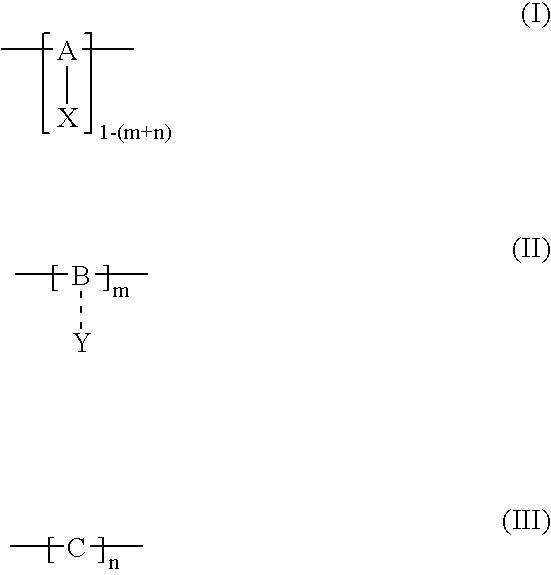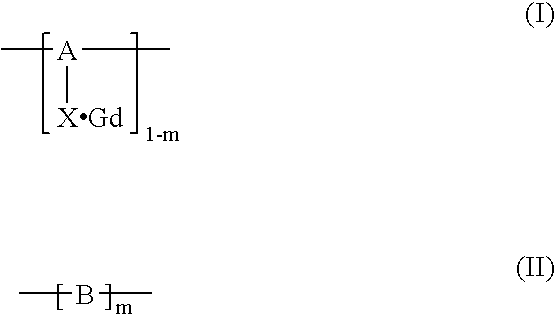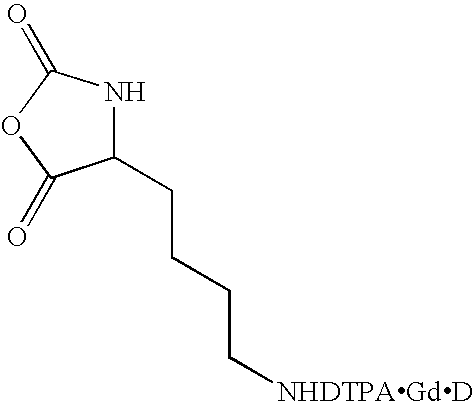Polymerization method for the synthesis of polypeptide imaging agents
a polypeptide and imaging agent technology, applied in the field of magnetic resonance imaging, can solve the problems of difficult to synthesize reliably high-conjugated polymers, unable to meet the needs of high-conjugated polymers, and tend to clear away quickly from the body, etc., to achieve the effect of increasing the conjugation of polymers
- Summary
- Abstract
- Description
- Claims
- Application Information
AI Technical Summary
Benefits of technology
Problems solved by technology
Method used
Image
Examples
example 1
Synthesis of Lysine-Nα-DTPA 5
(A) Synthesis of 9-BBN-Lysine Complex, 3, Depicted in Scheme 1
[0084]
[0085] A sample of lysine, 1, (1 eq) is stirred in MeOH (0.03M solution) at ambient temperature. An aliquot of a solution of 9-borobicyclononane (9-BBN) (1 eq), 2, in tetrahydrofuran (THF) is introduced by syringe, and the cloudy reaction mixture is stirred under refluxing conditions (˜50° C.) over 1 hour to give a clear colorless solution. The volatile organic solvents are removed under reduced pressure to give a solid that is then redissolved in warm (˜40° C.) THF and filtered to provide a colorless solution. The solution is filtered and the volatiles are removed in vacuo to afford 9-BBN-lysine, 3, as an off white solid, which is then washed with pentanes, dried in vacuo and used without further purification.
(B) Synthesis of 9-BBN-Lysine-DTPA, 4, Depicted in Scheme 2
[0086]
[0087] A sample of DTPA (1 eq) is added to a solution of acetonitrile (CH3CN, 0.1 M), followed by the addition ...
example 2
Alternate Synthesis of Lysine-Nε-DTPA 5
[0089] To a CH3CN solution (0.1M) is added DTPA (1 eq) and triethylamine (NEt3) (5 eq) to provide a cloudy solution that is then degassed for 20 mins before stirring at 55° C. for 1 hour. The resulting clear colorless solution is then cooled to −45° C. and isobutylchlorofomate (IBCF) (1.1 eq.) added dropwise over the course of about 20 minutes and stirred for 1 hour at −45° C. to give a white slurry. The slurry is then added to a clear dimethylformamide (DMF) solution of Nα-Boc-lysine (1 eq) and N-methylmorpholine (2 eq) followed by stirring at ambient temperature for 12 hours. The reaction mixture is then treated with acetylchloride (9 eq) in MeOH (0.1M) for 6 hours at ambient temperature at which point the volatiles are removed to afford a residue that is treated with NaOH (6 eq) in MeOH (0.1M) for 6hrs. The volatiles are removed in vacuo and the resulting residue is purified by reversed phase silica gel chromatography to isolate lysine-Nε-D...
example 3
Synthesis of Lysine-Nε-DTPA.Gd.Na 6, Depicted in Scheme 3
[0090] A sample of lysine-Nε-DTPA 5 (1 eq) from Example 1 or Example 2 is dissolved in H2O to form a 0.1M solution, which is added to a pH 6 buffer solution of GdCl3 (1.2 eq) and trisodium citrate (2.4 eq). The reaction mixture is stirred for 12 hours, the volume reduced under centrifugal vacuum and then twice passed through a Sephadex plug. The volume is reduced under centrifugal vacuum and then the reaction mixture is added to acetone (5 eq by volume). A white solid containing the product, lysine-Nε-DTPAGd.Na 6 precipitates, and the product 6 is isolated by filtration, followed by washing with acetone (3×10 mL) and drying in vacuo.
PUM
| Property | Measurement | Unit |
|---|---|---|
| temperature | aaaaa | aaaaa |
| temperature | aaaaa | aaaaa |
| temperature | aaaaa | aaaaa |
Abstract
Description
Claims
Application Information
 Login to View More
Login to View More - R&D
- Intellectual Property
- Life Sciences
- Materials
- Tech Scout
- Unparalleled Data Quality
- Higher Quality Content
- 60% Fewer Hallucinations
Browse by: Latest US Patents, China's latest patents, Technical Efficacy Thesaurus, Application Domain, Technology Topic, Popular Technical Reports.
© 2025 PatSnap. All rights reserved.Legal|Privacy policy|Modern Slavery Act Transparency Statement|Sitemap|About US| Contact US: help@patsnap.com



